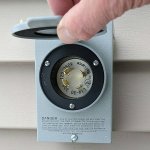I run a 2200w Honda during the night. The outside wall connection is a standard generator input plug. Inside on the other side of the wall is two duplex outlets. I run extension cords to the fridge, a couple lights, electronics, etc. Not very elegant but it works and the little generator will go 10 hours on a gallon.
I've got about the same setup as this, haven't needed it but it's there and ready to go if needed.
The double duplex outlets are by the back door where I can easily plug extension cords to the freezers and refrigerator with the larger generator. I also have a single outlet set up like that on the side of the house so that I can power the pellet stove with the little inverter generator.
No dangers of backfeeding the house circuits and no double male patch cords.


